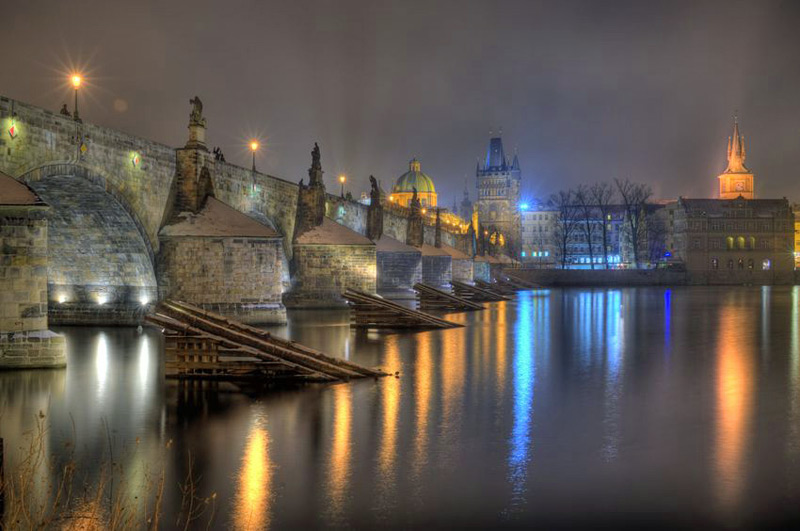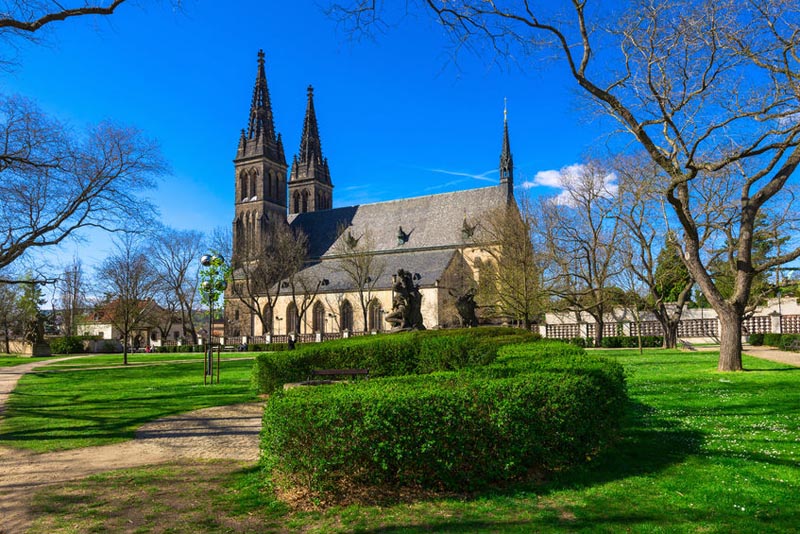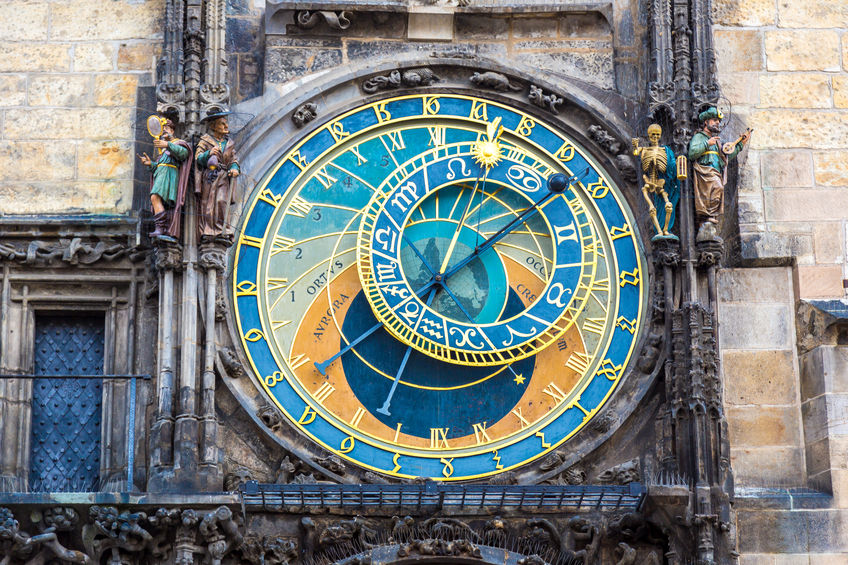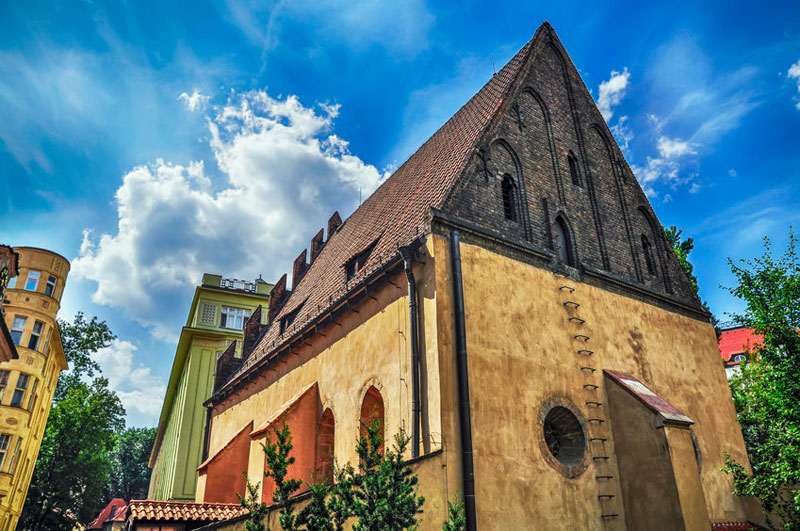There are so many myths and legends associated with the city of Prague that it is difficult to know where to begin. Some are gruesome, some are violent, some have the ring of truth about them and some are a little hard to believe. Regardless of whether or not you believe in ghosts and golems, the telling of these stories is an important part of the Czech Republic’s history, culture and identity. We have put together this list of some of the more well known legends associated with the city, along with the locations of specific streets, buildings and areas that they are linked to. You can make up your own mind about what to believe, but they are undoubtedly jolly good stories and all good stories find their basis in truth.
Charles Bridge
The beauty and majesty of Charles Bridge can’t be denied. To walk from one end to the other is a unique and humbling experience, which can inspire and lighten the soul. This is especially true if you set your alarm clock and get there early to beat the crowds. We recommend taking a stroll over the bridge between 6am and 7am to fully appreciate its majesty.
According to legend, Emperor Charles IV (who ordered the construction of the bridge) first consulted with astrologers to ascertain when would be the most “astrologically pleasing” time for the bridge to be completed. He believed that the exact moment that a thing came into being was highly significant in terms of its relationship with the world around it. The bridge’s last stone was put into place at 5:31am on July 9th 1357. The importance of this becomes clearer when you look at just the numbers: 135797531. They are ascending and descending odd digits. Whether or not Charles’s mania for detail really had any effect is up for debate but it’s impossible to deny that the durability and resilience of the bridge is quite remarkable. It has survived floods and wars and these days, thousands of people walk across it every day. There’s also no denying that special feeling you get as you wander over it.
It’s also possible that the bridge’s astonishing resilience comes from the fact that its builders added eggs to the motor. The eggs were delivered from all over the kingdom to be used in the bridge’s construction, as it was believed that they would add to its strength and durability.

The Legend of Jan Nepomucky
One of the many statues adoring the Charles Bridge is that of Jan Nepomucky (he is the one with 5 stars floating around his head). Nepomucky was a priest who took confessional with one of Vaclav IV’s wives. This proved to be a bad move on Nepomucky’s part, as the jealous Vaclav suspected his wife of committing adultery and demanded that the priest divulge what he had been told under the confidence of the confessional. Nepomucky refused and as a result, he was locked in a casket and thrown into the Vltava River. According to legend, as his casket sank, 5 stars were visible floating just above the surface of the water (explaining the 5 stars floating around the head of the statue).
The Legend of How Prague Came to Be
The story of how the city of Prague came into being is probably the city’s best known legend. For this story we need to go back to the 7th century, a time when the Czech lands were ruled by Princess Libuse and her husband Premysl. To say that Libuse was a bit of an eccentric leader, would be putting it mildly. She was famed for making many of her most important decisions (including the selection of her husband) on the basis of visions and prophecy. One day, Libuse was looking out over her lands from Vysehrad Castle, when she had one of her visions. In this particular vision she saw that a great city would be built around 5km away from where she was standing. Presumably, her people were well used to acting upon the whims of their princess and they immediately set out to the spot which had appeared in Libuse’s vision. There they found a man, who was building the threshold to his new home. “Prah” is the Czech word for threshold and according to the legend; this is where the city gets its name, Praha.

The Legend of the Astronomical Clock
There are several legends surrounding Prague’s famous Astronomical Clock. This one is certainly the most gruesome. According to the legend, the clock was created by Master Jan Hanus. Hanus was commissioned to make the clock by the councillors of the city of Prague and when it was finished, they were awed by its beauty and majesty. They were so awed that they decided that their clock must be the only clock of its quality in the world. In order to achieve this aim, they hatched a cruel and brutal plan. Their plan involved breaking into the home of Master Hanus and gauging out his eyes with an iron rod, making him incapable of recreating his masterpiece.
You’ll be pleased to hear that their plan backfired. With the assistance of a loyal pupil, Hanus made his way to the clock and managed to destroy it. The people of Prague were devastated and it was over 100 years until someone with the sufficient skill to fix it was found.

The Legend of the Prague Golem
This is a very popular legend and you will see countless references to it on Prague’s streets and to tell the story, we must go back to the 16th century. This was a time when the Jewish population was under attack by the wider community. Legend has it that Rabbi Loew created the Golem from clay found on the banks of the Vltava River and wrote “Emet” (meaning “truth” in Hebrew) across its forehead. The Golem was supposed to protect the Jewish community and could be awakened by a simple incantation. However, each time the incantation was used, the Golem became more violent and more unpredictable. He began killing people and Rabbi Loew was asked to destroy his creation in exchange for the promise of safety for his people. The Rabbi obliged, and removed the initial letter E from the golem’s forehead, leaving simply “met” (meaning “death” in Hebrew). Legend has it that the Golem was left to turn to dust in the attic of the New-Old Synagogue. However, some people say that Rabbi Loew’s son eventually found and reawakened his father’s creation to once more walk Prague’s streets.

The New-Old Synagogue is the oldest preserved Synagogue in Europe and can be found in Josefov (Prague’s Jewish quarter) at Maiselova 18, 110 01 Praha 1.
The Legend of the Drowned Maid
The beautiful Dum u Zlate Studny in Prague’s Old Town is the setting for this chilling tale. Rumours had long been circulating in the local watering holes that a large amount of treasure was hidden in this building’s well. One evening, a curious maid called Lubomira, who worked in the building and dreamed of better things, came looking for the loot. Whilst peering curiously into the well’s depths, she over-balanced and fell into the well. Nobody was there to hear her cries and she eventually drowned. It is said that the building is haunted to this day by the dripping wet ghost of a young girl, with hair plastered to her face and her teeth chattering with cold.
If you’re interested in a spot of ghost hunting, Dum u Zlate Studny is just a short walk from Old Town Square at U Zlaté studně 166/4, Praha 1.
The Legend of Daliborka Tower
Daliborka Tower is part of the Prague Castle Complex and is the setting for this somewhat poignant tale. Up until the end of the 18th century, the tower was used as a prison and it actually takes its name from the first prisoner who was ever held there, a knight by the name of Dalibor.
Dalibor was imprisoned for allowing rebellious peasants to shelter in his home, rather than sending them back to their masters. In this respect he was probably a pretty decent chap. Legend has it that during his period of imprisonment, Dalibor learned to play the violin so beautifully that crowds of people would gather at the base of the tower to listen to the hauntingly beautiful sound of his music. His execution was never formally announced as it was not necessary to do so. People knew that the knight had been killed when his music could no longer be heard from the tower.
The story of Dalibor was turned into an opera by Czech Composer Bedrich Smetana in 1868.
Entry to the tower is possible as part of the Prague Castle Short tour (250 CZK).
Honest Tips For Your Prague Stay
AIRPORT TRANSFER Get a private transfer from/to Prague Airport for a price of regular taxi (€31).
PRAGUE CITY CARD Save time and money with Prague Card, and see 60+ sights for free.